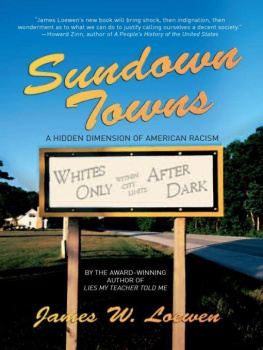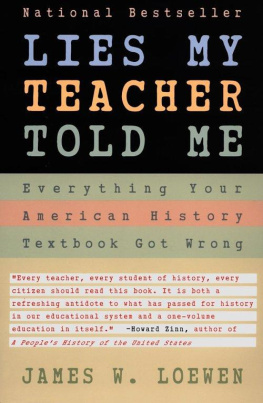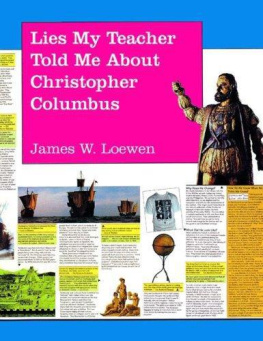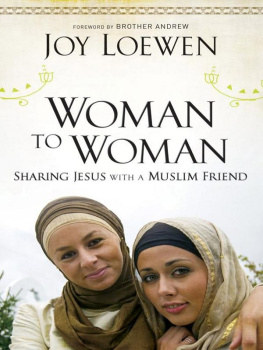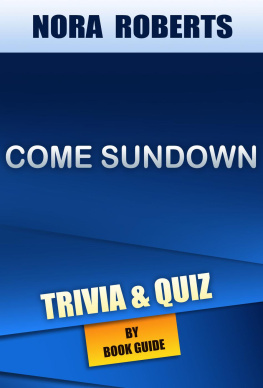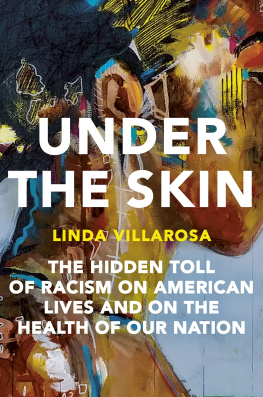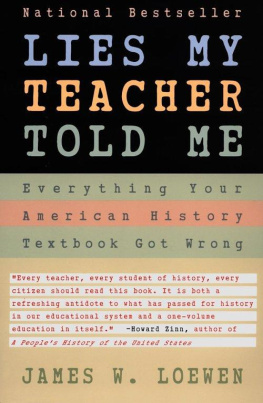Table of Contents
Also by Jim Loewen
Lies Across America: What Our Historic Sites Get Wrong
Lies My Teacher Told Me:
Everything Your American History Textbook Got Wrong
The Mississippi Chinese: Between Black and White
Mississippi: Conflict and Change (with Charles Sallis, et al.)
Social Science in the Courtroom
The Truth About Columbus:
A Subversively True Poster Book for a Dubiously Celebratory Occasion
Note to the Reader
Readers may need to brace themselves to deal with the language they will meet in this book. I shall not soften it by using n-word or other euphemisms. People said what they said and wrote what they wrote; their language is part of the story. Indeed, this language is part of what makes sundown towns distinctive, so I could not tell their story honestly while expurgating the language.
Younger readers need to understand that Negro was the standard term used to refer to African Americans before about 1972, by blacks as well as whites, and connoted no disrespect. Before about 1950, writers did not always capitalize Negro, although since it was parallel to Caucasian, they should have. I have taken the liberty of capitalizing negro in quoted sources from these earlier years. When writers used negro even after 1972long after most authors had converted to black or African American I have left negro uncapitalized. After 1972, writers who persist in using negro demonstrate either a deliberate refusal to use black or to capitalize Negro or an appalling ignorance of correct usage, which I would not want to mask from my readers. Such writing would be uncommon in a multiracial town by 1974.
Occasionally I place quotation marks around a name at first occurrence, indicating that the name is fictitious. Some other names have been omitted or disguised, to avoid any repercussion to people who kindly shared information with me, because the informant asked not to be identified, or because I did not know them.
Notes placed in the midst of paragraphs are content footnotes. Reference footnotes come at the end of paragraphs. In the references, web sites are listed without http:// or www.and are followed by the date accessed. Names followed by datesJane Doe, 9/2002refer to interviews in person or by phone.
I dont footnote the U.S. census; finding population figures there is not hard and not eased much by citations. In the 2000 census I used the single-race counts, because it is not clear how an individual who states two or three races on the census form identifies in society, because the census uses single-race data for important tables such as households, and because only 2.4% of census respondents chose more than one race.
Often I quote from e-mails. Unfortunately, not to bother to write e-mails in correct English has become conventional, perhaps because this ephemeral electronic form is viewed as intermediate between talking and writing. Since quoting changes the form to traditional written, I have usually taken the liberty of correcting minor lapses in spelling and grammar in e-mails.
PART I
Introduction
The Importance of Sundown Towns
Is it true that Anna stands for Aint No Niggers Allowed? I asked at the convenience store in Anna, Illinois, where I had stopped to buy coffee.
Yes, the clerk replied. Thats sad, isnt it, she added, distancing herself from the policy. And she went on to assure me, That all happened a long time ago.
I understand [racial exclusion] is still going on? I asked.
Yes, she replied. Thats sad.
conversation with clerk, Anna, Illinois, October 2001
A NNA IS A TOWN of about 7,000 people, including adjoining Jonesboro. The twin towns lie about 35 miles north of Cairo, in southern Illinois. In 1909, in the aftermath of a horrific nearby spectacle lynching, Anna and Jonesboro expelled their African Americans. Both cities have been all-white ever since. Nearly a century later, Anna is still considered by its residents and by citizens of nearby towns to mean Aint No Niggers Allowed, the acronym the convenience store clerk confirmed in 2001.
It is common knowledge that African Americans are not allowed to live in Anna, except for residents of the state mental hospital and transients at its two motels. African Americans who find themselves in Anna and Jonesboro after darkthe majority-black basketball team from Cairo, for examplehave sometimes been treated badly by residents of the towns, and by fans and students of Anna-Jonesboro High School. Towns such as Anna and Jonesboro are often called sundown towns, owing to the signs that many of them formerly sported at their corporate limitssigns that usually said Nigger, Dont Let the Sun Go Down on You in __. Anna-Jonesboro had such signs on Highway 127 as recently as the 1970s. These communities were also known as sunset towns or, in the Ozarks, gray towns. In the East, although many communities excluded African Americans, the term sundown town itself was rarely used. Residents of all-white suburbs also usually avoided the term, though not the policy.
Sundown Towns Are Almost Everywhere
A sundown town is any organized jurisdiction that for decades kept African Americans or other groups from living in it and was thus all-white on purpose. Thus an all-white town may include nonblack minorities and even a tiny number of African Americans.
It turns out that Anna and Jonesboro are not unique or even unusual. Beginning in about 1890 and continuing until 1968, white Americans established thousands of towns across the United States for whites only. Many towns drove out their black populations, then posted sundown signs. (Portfolio 7 shows an example.) Other towns passed ordinances barring African Americans after dark or prohibiting them from owning or renting property; still others established such policies by informal means, harassing and even killing those who violated the rule. Some sundown towns similarly kept out Jews, Chinese, Mexicans, Native Americans, or other groups.
Independent sundown towns range from tiny hamlets such as De Land, Illinois (population 500), to substantial cities such as Appleton, Wisconsin (57,000 in 1970).
Outside the traditional Southstates historically dominated by slavery, where sundown towns are rare probably a majority of all incorporated places kept out African Americans. If that sentence startles, please suspend disbelief until Chapter 3, which will show that Illinois, for example, had 671 towns and cities with more than 1,000 people in 1970, of which 47571%were all-white in census after census. Chapter 3 will prove that almost all of these 475 were sundown towns. There is reason to believe that more than half of all towns in Oregon, Indiana, Ohio, the Cumberlands, the Ozarks, and diverse other areas were also all-white on purpose. Sundown suburbs are found from Darien, Connecticut, to La Jolla, California, and are even more prevalent; indeed, most suburbs began life as sundown towns.
Sundown towns also range across the income spectrum. In 1990, the median owner-occupied house in Tuxedo Park, perhaps the wealthiest suburb of New York City, was worth more than $500,000 (the highest category in the census). So was the median house in Kenilworth, the richest suburb of Chicago. The median house in Pierce City, in southwestern Missouri, on the other hand, was worth just $29,800 and in Zeigler, in southern Illinois, just $21,900. All four towns kept out African Americans for decades.
This History Has Been Hidden


